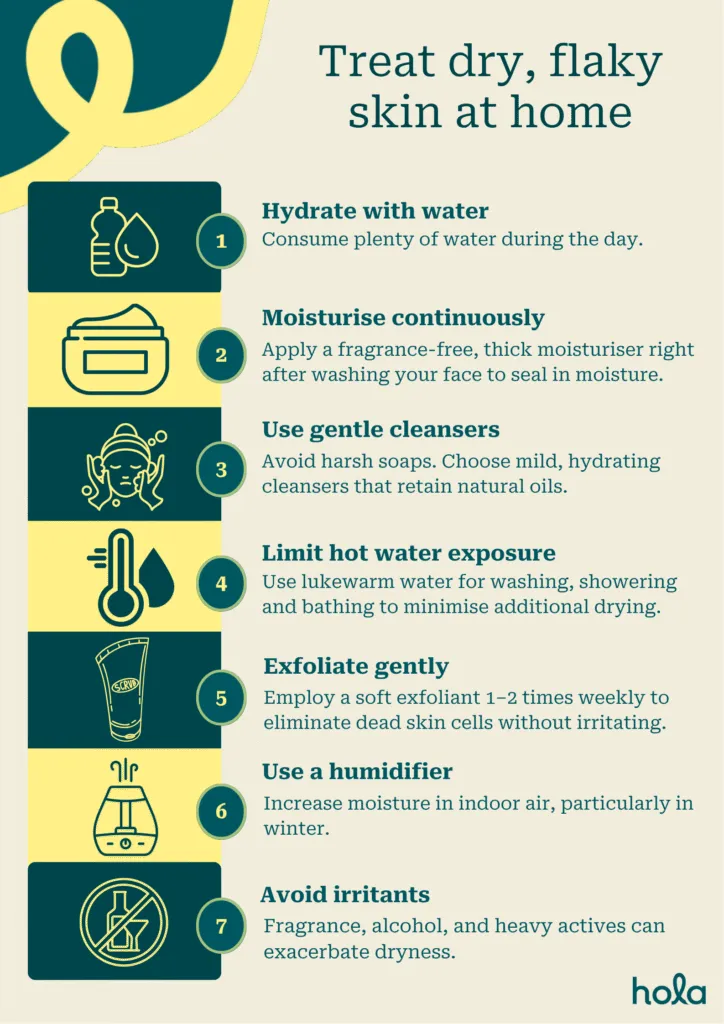What causes dry skin on legs & face
Written by the editorial staff writer at Hola. Medically Reviewed by Dr. Ammar AL-ANI, MBChB, CCBST, AMC.

Contents

Summary: Dry skin on the legs and face is a common concern triggered by factors such as weather changes, prolonged hot showers, harsh soaps, ageing, underlying skin disorders, dehydration, and certain medications. While it’s typically not a major health risk, it can be an uncomfortable experience. However, with a consistent skincare regimen, proper hydration, and using gentle, nourishing products, dry skin can often be effectively managed and prevented.
Dry skin, also known as xerosis in medical terms, is a widespread condition that affects individuals across all age groups and backgrounds. A survey1 conducted in an Australian hospital found that xerosis was the leading skin condition, impacting 29.5% of patients. It often appears on the legs and face, causing the skin to feel tight, rough, flaky, or itchy. While usually not serious, dry skin can be irritating, and if ignored, may lead to more severe skin problems. Knowing the underlying causes is essential for finding effective relief and preventing future flare-ups.
How dry skin can appear suddenly or gradually
Dry skin can build up gradually over time due to factors like ageing, repeated exposure to harsh climates, or consistent use of drying soaps. In these cases, the skin slowly loses moisture, leading to a rough and patchy skin. Alternatively, dry skin can occur abruptly due to immediate triggers like an allergic reaction, a new skincare product, drastic weather shifts, illness, or lack of fluids. The rapid onset may cause redness, itching, or tightness. Understanding whether dry skin appears gradually or suddenly can help determine the trigger and select the best remedy.Is dry skin a common issue?
Dry skin is a common issue that many individuals encounter, especially during colder seasons or environmental changes. When temperatures drop or humidity levels fall, the skin may lose its natural moisture barrier, resulting in flakiness, tightness, or irritation. Lifestyle choices such as frequent bathing, using harsh soaps, heating systems, or dehydration can also deplete the skin of vital oils. Modifying your skincare routine with hydrating moisturisers, gentle cleansers, and protective measures can alleviate dryness and promote healthy skin.What is dry skin?
Dry skin is a prevalent condition characterised by insufficient moisture or natural oils, leading to roughness, flaking, itchiness, or tightness. It can affect any area of the body, but is most frequently seen on the hands, arms, legs, and face. Dry skin can be temporary, resulting from weather changes or chronic, associated with underlying skin disorders like eczema or psoriasis. Effective management involves proper hydration, moisturising, and mild skin care. If symptoms escalate or do not improve with home care, it might be advisable to consult a doctor.Difference between normal skin shedding and problem-level dryness.
Normal skin shedding is a healthy biological process in which old skin cells are replaced by new ones. This process happens gradually and typically goes unnoticed. Conversely, problematic dryness involves excessive flaking, itching, cracking, or redness. It usually feels tight or rough and may cause discomfort or noticeable irritation. While normal shedding promotes skin health, abnormal dryness could indicate a lack of moisture or an underlying skin issue that needs treatment.What causes dry skin on the legs?
Dry skin on the legs can arise from several typical factors, such as:- Insufficient moisture: The skin on the legs contains fewer oil glands, making it more vulnerable to dryness, particularly during colder seasons or in arid climates.
- Regular hot showers: Extended exposure to hot water can eliminate the skin’s natural oils, resulting in dryness and peeling.
- Strong soaps or detergents: Employing harsh cleansers or detergents may harm the skin barrier and diminish moisture levels.
- Incorrect shaving techniques: Shaving on dry skin or without using a moisturising cream can lead to irritation and dryness.
- Health issues: Conditions such as eczema, psoriasis, or diabetes may trigger or exacerbate dry skin on the legs.
- Ageing: As we grow older, our skin naturally generates less oil, increasing its likelihood of becoming dry.
- Inadequate hydration or nutrition: Failing to drink enough water or lacking essential fatty acids can influence skin hydration from the inside out.
Feeling sick and unsure why? Speak with a GP online in 15 minutes.
See a Doctor now
Available 24/7, across Australia.
Common causes of dry skin on the face
Dry skin on the face can stem from various environmental, lifestyle, and health-related factors, such as:- Weather changes: Cold air, low humidity, and wind can draw moisture away from the skin.
- Over-cleansing: Harsh soaps, frequent washing, or using hot water can harm the skin barrier.
- Skincare products: Items containing alcohol, fragrance, or potent actives may irritate or dry the skin.
- Dehydration: Insufficient water intake impacts skin hydration.
- Underlying conditions: Conditions like eczema, psoriasis, or hypothyroidism can contribute to facial dryness.
- Ageing: The natural production of oils decreases with age, leading to drier skin.
- Sun exposure: UV rays can damage the skin’s moisture barrier over time.
How to treat dry, flaky skin at home
Addressing dry, flaky skin at home requires gentle treatment and regular hydration. Here's how to do that:- Moisturise consistently: Apply a fragrance-free, thick moisturiser right after washing your face to seal in moisture.
- Use gentle cleansers: Avoid harsh soaps. Choose mild, hydrating cleansers that retain natural oils.
- Limit hot water exposure: Use lukewarm water for washing, showering and bathing to minimise additional drying.
- Exfoliate gently: Employ a soft exfoliant 1–2 times weekly to eliminate dead skin cells without irritating.
- Stay hydrated: Consume plenty of water during the day.
- Use a humidifier: Increase moisture in indoor air, particularly in winter.
- Avoid irritants: Fragrance, alcohol, and heavy actives can exacerbate dryness.

When & why to consult with online doctors
Consulting with online doctors is a convenient option for those needing prompt medical guidance without the inconvenience of travel or lengthy wait times. It is particularly suitable for non-emergency issues like skin problems, cold and flu symptoms, urinary tract infections, allergies, or mental health matters. You should also seek help if you require a prescription renewal, a medical certificate, or follow-up care. Online doctors provide quick, private, and professional assistance, often available around the clock. They enable you to address health concerns conveniently from home, which is especially advantageous if you're unwell, busy, or reside in a remote location. Services such as Hola Health facilitate telehealth consultations with licensed GPs, prescription services, and referrals, all through online platforms. It’s healthcare that fits into your schedule and promotes your well-being.Conclusion:
Dry skin on the legs and face is typically triggered by a combination of environmental, lifestyle, and medical factors. With appropriate care, such as using mild skincare products, proper hydration, and maintaining skin wellness, it can often be managed and prevented.Doctor's Guide to Dry Skin (Xerosis)
| What is Dry Skin (Xerosis)? | A common condition where the skin lacks moisture or natural oils, causing roughness, flaking, itchiness, or tightness. |
|---|---|
| Prevalence in Australia | 29.5% of hospital patients in one study had xerosis, making it a leading skin condition. |
| Common Areas Affected | Legs, face, hands, and arms. |
| Gradual Onset Causes | Ageing, harsh climate exposure, regular use of drying soaps. |
| Sudden Onset Triggers | Allergies, new skincare products, weather changes, dehydration, or illness. |
| Difference: Shedding vs. Problem Dryness | Normal shedding is unnoticeable; problematic dryness includes flaking, itching, and visible irritation. |
| Common Causes – Legs | - Fewer oil glands - Hot showers - Harsh soaps - Improper shaving - Skin conditions - Ageing - Dehydration or poor nutrition |
| Common Causes – Face | - Cold, dry weather - Over-cleansing - Irritating skincare products - Dehydration - Eczema, psoriasis, hypothyroidism - Ageing - Sun exposure |
| Home Treatment Tips | - Use thick, fragrance-free moisturisers - Gentle cleansers - Lukewarm water only - Mild exfoliation 1–2x/week - Drink water - Use a humidifier - Avoid irritants like alcohol/fragrance |
| When to See a Doctor | - If dry skin is severe or painful - No improvement with moisturisers - Signs of infection - Other symptoms or chronic conditions present |
| Telehealth for Dry Skin | - Yes, online doctors can assess, prescribe treatment, and offer advice virtually. - Available 24/7 via services like Hola Health. |
| Online Prescriptions | Yes, for moisturisers, steroid creams, antihistamines, etc., via eScript in Australia. |
| Could Dry Skin Indicate Something Serious? | Sometimes. Possible underlying conditions: - Eczema or psoriasis - Diabetes - Kidney disease - Thyroid disorders - Malnutrition |
| Diet’s Role | Essential nutrients for skin health: - Vitamin A & E - Zinc - Omega-3 fatty acids - Water Poor diet, alcohol, and caffeine can worsen dryness. |
| Winter and Dry Skin | Worse in winter due to low humidity, cold air, indoor heating, and long hot showers. Use moisturisers and humidifiers to counter this. |
| Is Flaky Skin Always Dry Skin? | No. Can also be caused by: - Eczema or psoriasis - Fungal infections - Allergic reactions - Nutritional deficiencies - Peeling after sunburn |
FAQs
When should I see a doctor for dry skin?
You should consult a doctor for dry skin if it’s severe, doesn’t improve with moisturisers, becomes itchy or sore, shows signs of infection (such as redness, inflammation, or pus), or if it’s associated with other symptoms or an underlying medical issue.Can I get treatment for dry skin through telehealth?
Yes, you can get treatment for dry skin through telehealth. A doctor online can evaluate your condition, recommend suitable moisturisers or therapeutic creams, suggest lifestyle changes, and prescribe treatment if necessary–all through a virtual consultation by phone or video.Can I get an online prescription for eczema or dry skin?
Yes, in Australia, you can get an online prescription for eczema or dry skin through telehealth. A licensed doctor can assess your condition through a video consultation and issue an electronic prescription (eScript) for treatments like moisturisers, steroid creams, or antihistamines. You may then collect them from your preferred pharmacy or opt for home delivery.Can dry skin be a sign of something more serious?
Dry skin can sometimes indicate something more serious. While it is often due to weather, skincare habits, or ageing, it can also suggest:- Eczema or psoriasis
- Diabetes
- Kidney disease
- Thyroid disorders
- Malnutrition or vitamin deficiencies
Does diet affect dry skin?
Yes, diet can affect dry skin. A deficiency in certain vitamins and minerals can leave your skin feeling dry, rough, or peeling. Essential nutrients for maintaining soft, well-hydrated skin include:- Vitamin E
- Vitamin A
- Zinc
- Omega-33 fatty acids
- Water
Is dry skin worse in winter?
Yes, dry skin often tends to worsen in winter. Cold air, low humidity, and indoor heating remove moisture from the skin, causing it to feel tight, flaky, or itchy. Wind exposures and hot showers in winter can also damage the skin’s protective barrier. Using a good moisturiser, avoiding prolonged hot baths, and using a humidifier indoors can help protect your skin during colder months.Is flaky skin always dry skin?
Not always. While flaky skin is often associated with dryness, it isn’t always caused by dry skin alone. Flakiness can also result from:- Skin conditions like eczema or psoriasis
- Fungal infections
- Allergic reactions
- Nutritional deficiencies
- Peeling after sunburn
Running low on meds? Get an online script from home in minutes.
Request an instant script
Available 24/7, across Australia.
What we treat
- Cough
- Nausea & vomiting
- Fever
- Hayfever
- Fatigue
- Sore throat
- Acne
- Hair loss
- Gout
- Eczema
- Rosacea
- Sunburn
- UTI
- Erectile dysfunction
- Contraception
- Morning sickness
- Morning after pill
- Prostate health
- Anxiety
- Depression
- Stress
- Grief & loss
- Antidepressants
- Premature ejaculation
- Asthma
- Blood pressure
- Blood thinners
- Diabetes
- Cholesterol
- Migraines & headaches
- Allergies
- Body ache
- Heartburn & reflux
- Sleep disorder
- Pain relief
- Gastro
Related Articles
Disclaimer
This blog is for general informational purposes only and does not indicate that Hola Health provides all treatments or preventive measures mentioned. It is not intended to be a substitute for professional medical advice. Always seek the guidance of your doctor or other qualified health professional with any questions you may have regarding your health or a medical condition. For emergencies please immediately contact 000. Any medical topics discussed are intended to educate, not to imply availability through Hola Health.
 Facebook
Facebook  X
X  Copy Link
Copy Link



